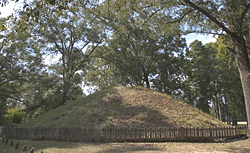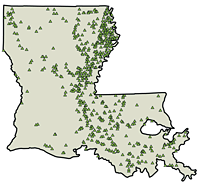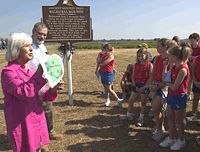
Posted on 12/10/2004 1:00:11 PM PST by blam
Following the Trail of Ancient Louisianians
December 9, 2004
by Amélie A. Walker

A mound at Marksville, one of the state-owned sites on the Louisiana Ancient Mounds Trail. (Mark J. Sindler/LA Office of Tourism)
Known for Mardi Gras, jazz, and Cajun culture, Louisiana also has a wealth of Native American sites dating to as early as 4000 B.C. The most obvious remains of ancient peoples are the many mounds that can be seen throughout the state, in cotton and soybean fields, hidden in woods, or even under houses. In all, there are more than 700 mound complexes or individual mounds in Louisiana. Built over millennia, they include some of the oldest and best-preserved such structures in North America.
Mound building began around 6,000 years ago, at a time when people were becoming more sedentary, though not yet involved in agriculture, and continued until the period of European contact. The first mounds may have marked seasonal homes with abundant resources for nomadic hunter-gatherers, but mounds were used for different purposes at different times and places. Burials have been found in some mounds, while archaeologists have identified house patterns and found domestic objects on mounds that were apparently residential sites. Others likely served religious purposes. Whatever their use, these earthen structures are a reminder of cultures past, a heritage that should be protected and shared.
To celebrate Louisiana's Native American mounds, a series of historical markers has now been installed, creating the Ancient Mounds Trail. Currently made up of 37 sites that can be viewed from public highways, the trail's purpose is to educate the public about the state's earliest people while also diversifying and expanding tourism. The mounds are a lesser-known aspect of Louisiana's past, one that the state would like to better publicize and make accessible. More visitors would be especially welcome in mound-rich northeastern Louisiana, the region that currently receives the smallest number of tourists.

Ancient mounds are found throughout Louisiana, but they are most concentrated in the northeast. (Courtesy Louisiana Division of Archaeology)
The idea for a trail came from the desire of the state's Division of Archaeology to recognize the sites and make those that could be seen from the right of way available to the public. Northeast Louisiana Regional Archaeologist Joe Saunders and Reca Jones, the woman who discovered the Middle Archaic site of Watson Brake and is now an assistant in the Northeast Regional Archaeology Program, started the process. They began identifying the mound sites that are viewable from highways and contacting the landowners to see if they would be willing to participate in a trails program. The Division of Archaeology secured Federal Highway Administration funds from the Department of Transportation and Development in Louisiana to mark the sites with historical markers and to develop a guidebook that would provide more information for those wishing to follow the trail.
Participation of private landowners was critical to the success of this project. A few of the sites--Poverty Point, Marsden, and Marksville--are owned by the public, but most mounds are in private hands. The Ancient Mounds Trail is part of a greater Heritage Area, which itself is mostly made up of mounds on private property that landowners have agreed to protect. The state has been quite successful in landowner cooperation and stewardship, and there are about 80 sites and 86 owners involved so far. The private owners have agreed to become stewards, whereby they protect the sites from looting, farming, and other activities that would damage the mounds or other archaeological remains. There is no payment involved, each participating landowner gets a certificate of appreciation and recognition. There are means by which they can obtain an easement for their site with the Louisiana Archaeological Conservancy, providing them with tax benefits, but this is not part of the program's objective.

Reca Jones and Tom Eubanks talk to a school group at Balmoral Mounds, a privately owned site on the trail. (Mark J. Sindler/LA Office of Tourism)
When asked how long it's taken to get the trail together, State Archaeologist Thomas Eubanks said, "It's one of these things. You can't do the guidebook until you have markers in the ground, and you can't have the markers in the ground until the landowners agree. It's just taken a lot more time than we originally envisioned it would take." On top of all this is the still-in-progress process of verifying the information they have about the sites so that the historical markers are accurate and the guidebook can be written. This includes coring many of the mounds to get carbon samples for dating and to determine whether they were constructed in multiple stages. It also entails surveying the sites for the guidebook maps. The mapping is also necessary for the landowners to know the extent of the sites they are protecting that extend beyond the mounds themselves. The information on the trail's mounds must be as correct and up-to-date as possible, as a historical marker is permanent once it is created and installed. Eubanks says it has taken six or seven years since the project began to get to the point of putting the markers in the ground.

(Courtesy Louisiana Division of Archaeology)
The Louisiana Ancient Mounds Trail is about a five-hour tour by car with stops at the museums at Poverty Point in West Carroll Parish and Marksville in Avoyelles Parish, which serve as the hubs to the trail. Individuals or groups with an interest in learning more about mound sites in Louisiana can start near Epps at the Poverty Point State Historic Site. There they will be introduced to mound building by watching a video, looking through the museum, and touring the site itself. They can then drive to see the other sites with a better understanding of the mounds and the people who constructed them. The next state-owned site on the trail is Marsden, a group of mounds incorporated into Poverty Point Reservoir State Park and recently opened to the public. Though no full visitor's center is planned at Marsden, there will eventually be more interpretative materials available there, and visitors can arrange for guided tours. Following the trail from northeast to central Louisiana, most of the rest of the historical markers are on privately owned mounds. These sites can be viewed from highways or to the extent each landowner allows (these markers will all have "No Trespassing" signs on their posts). The tour ends at Marksville, where there is another interpretive center. (See larger map and images.)
Louisiana's Division of Archaeology hopes the trail will enhance appreciation for the mounds' significance and highlight the need to protect them. Because the state will never be able to own all of these sites, it is important for landowners and the general public to understand that the preservation of this cultural resource is to a great extent in their hands. "If we don't work toward private protection of archaeological sites, we're really losing the resource base as a whole," says Eubanks, who stresses educating the public in the long-term benefit of saving the sites. "What we're doing is enhancing protection by reinforcing with the landowners the importance of the sites, so that the public can understand that looting or digging at the site is not responsible."
The 50-page interpretive guide and map of the Louisiana Ancient Mounds Trail will be published in January 2006. Until then, brochures and a trail map are available at Poverty Point and Marksville or by contacting the Louisiana Division of Archaeology at archaeology@crt.state.la.us or visiting their website.
Amélie A. Walker, a native of Louisiana, is online editor and webmaster for ARCHAEOLOGY. She wishes to thank Louisiana's Department of Culture, Recreation, and Tourism for its generous assistance.
Mardi Gras in this country began is Mobile, Alabama.
Poverty Point is one of the best archeological sites in the state.
"Poverty Point is a major archaeological mystery. The mystery centers on the ruins of a large prehistoric Indian settlement, the Poverty Point site. There on a bluff top overlooking Mississippi River swamplands in northeastern Louisiana is a group of artificial mounds and embankments. It is not the earthworks themselves that are so mysterious. Eastern North America is, after all, the land of the "Mound Builders." These people once were thought to be a highly advanced, extinct race, but now are known to be ancestors of Native Americans, such as the Creek, Choctaw, Shawnee, and Natchez. The real mystery lies in the size and age of the earthworks. They are among the largest native constructions known in eastern North America, yet they are old, older than any other earthworks of this size in the western hemisphere."
You are talking about my neighborhood so I guess I live on that on that Ancient Mounds trail. I am just a few miles from Poverty Point.
We've found a few arrowheads on our land over the years when we were plowing the fields.
They have found evidence of ancient travelers from Colorado and Michigan from the artifacts made from materials not found in Louisiana.
Please FREEPMAIL me if you want on, off, or alter the "Gods, Graves, Glyphs" PING list --
Archaeology/Anthropology/Ancient Cultures/Artifacts/Antiquities, etc.
The GGG Digest -- Gods, Graves, Glyphs (alpha order)
Myth of the Hunter-Gatherer
Archaeology ^ | September/October 1999 Volume 52 Number 5 | Kenneth M. Ames
Posted on 08/13/2004 12:07:48 AM PDT by SunkenCiv
http://www.freerepublic.com/focus/f-bloggers/1190694/posts
THX!
Moundbuilders lived in Alabama, Georgia, Tennessee, and Indiana too.
So that's why Mobile is so famous! ;>)
Ha,ha. It was probably the below.
"By 1864, Mobile, Alabama, was the last Gulf Coast port of any consequence still remaining in Confederate hands. "
"Damn The Torpedos, Full Speed Ahead"
GGG ping. I think I screwed up the list I used for the main ping.
2022 bump.
My great-great grandparents. Daigle and Landry. Just about as Cajun (or as we say here, coon-ass) as it gets.
Marie Amelia Landry Daigle
https://www.findagrave.com/memorial/100144746/marie-amelia-daigle
Francois Augustin Daigle
https://www.findagrave.com/memorial/100144213/francois-augustin-daigle
This topic was posted , thanks blam.
I was watching a law and order program last night and it was from St Landry Parish.
"The French community built St. Landry Catholic Church in 1765, dedicated to St. Landry (Landericus) of Paris, the Bishop of Paris in the 7th century.[5] "
Louisiana is the only US state that does not have their laws based in old English laws. Their base is in French law.
Corporations from out of state leave most of their lawyers at home when they have to deal with Louisiana courts....they hire Louisiana lawyers.
I know a guy who studied Louisiana law...he is making gobs of money that way.
I'd be interested in how it was determined how they were hunter-gatherers. My guess is, it's just a preconceived notion based on outmoded ideas of how long people have been in the Americas and, uh, whatnot. Here's the rest of the Watson Brake keyword:
Louisiana succession laws have a feature called “forced heirship” which dictates how an estate is disposed. Derived from the Napoleonic Code.
https://en.wikipedia.org/wiki/Forced_heirship
In this morning’s local Gannett rag. The Ouachita River valley is about 30 miles east of me.
This Louisiana archaeological site predates Stonehenge and the pyramids: check out its history
https://en.wikipedia.org/wiki/Watson_Brake
Disclaimer: Opinions posted on Free Republic are those of the individual posters and do not necessarily represent the opinion of Free Republic or its management. All materials posted herein are protected by copyright law and the exemption for fair use of copyrighted works.